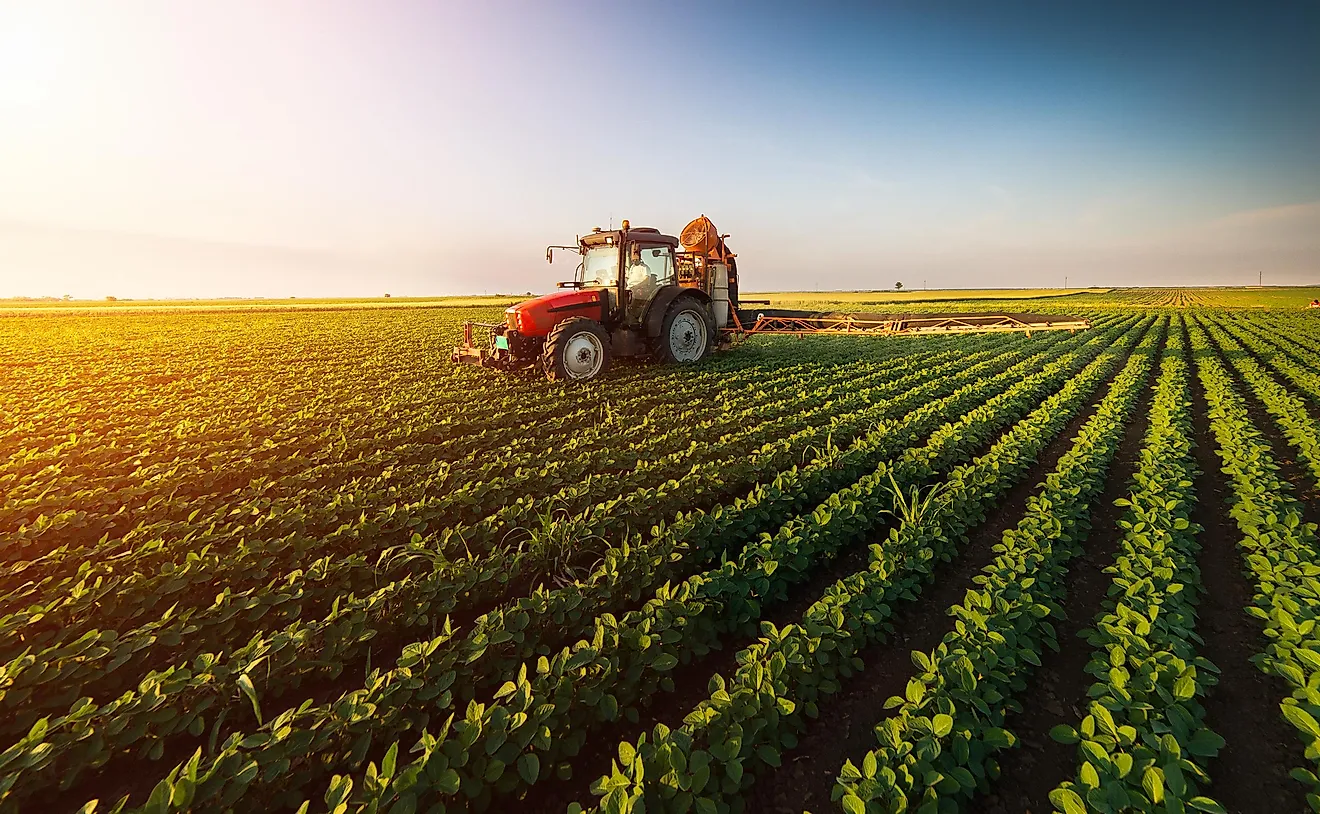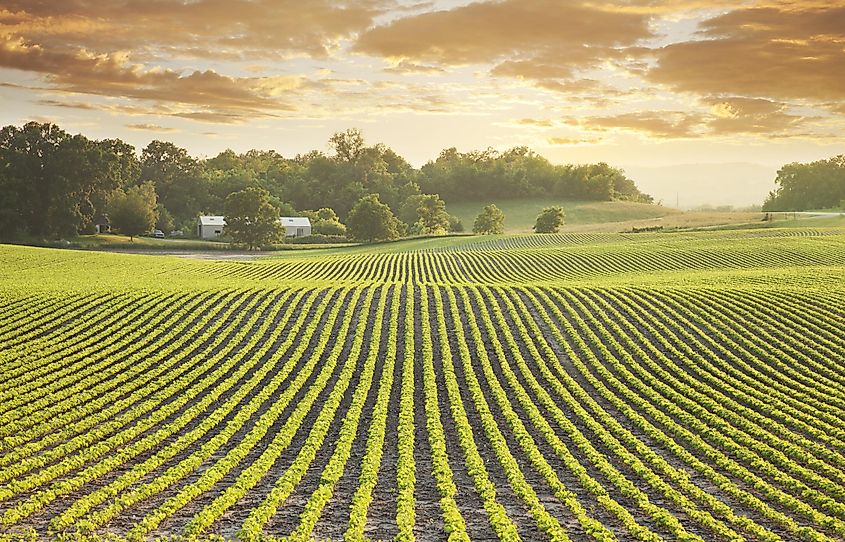US States Where Agriculture Drives The Economy

- The United States is one of the top exporters of food on the planet.
- California produces the most food in the United States by value.
- Texas has the highest number of farms in the United States.
Agriculture is one of the leading industries in the United States, which contributed over $1.053 trillion to the country’s GDP. The U.S. is the leading exporter of food on the planet. According to the Census Of Agriculture of 2007, there were over 2.2 million farms in the country, which occupied a total area of about 922 million acres. Even though agricultural activities occur in every American state, it is mainly concentrated in the eastern parts of the Rocky Mountain and Great Plains, among other places. The western drier half of the country is referred to as the Wheat Belt while the eastern wetter half is known as the Corn Belt. Historically, the American South has been the leading producer of Rice, tobacco, and cotton, but agricultural production has declined in the region over the last century. As of 2008, the agricultural sector had employed about 2% of the American population directly. There were over 3.2 million ranchers, farmers, and agricultural managers in the country in 2012. Agriculture is still a major industry in several American states, including:
California
Agriculture is an important sector in California’s economy, which earned them about $50 billion in 2018. Agricultural related sales in California quadrupled from $7.3 billion (1974) to 2004 ($31 billion), despite the 15% reduction in farmland. California produces over 400 crops, and this includes a considerable percentage of the nuts and fruits in the country. In 2017, there were about 77,100 ranches and farms in California occupying an area of about 25.3 million acres. Some of the leading commodities in California by value in 2017 included dairy products ($6.56 billion), grapes ($5.79 billion), almonds ($5.6 billion), and cannabis ($3.1 billion) among others. California produced over 90% of the avocados in the country in 2017. California was the second-biggest rice producer in the country in 2006. California produces over 90% of American wine.
Iowa
With some of the most productive and richest soil on the planet, more than 90% of its Iowa’s land is used for agriculture. Iowa ranks second in agricultural production in the United States and also second in total agricultural export. The agricultural sector of Iowa managed to export goods worth $10 billion in 2013. Agriculture is a crucial sector in Iowa, which contributed about 3.5% of the state’s GDP in 2007. Iowa leading agricultural commodities are cattle, hogs, soybeans, and corn, among others. Iowa is the largest producer of corn and ethanol. Iowa is one of the top producers of soybeans in the country. The 92,600 Iowan farms produced over 19% of the American corn, eggs (14%), hogs (30%), and soybeans (17%) in 2008. Viticulture is of great importance in Iowa, which has hundreds of vineyards. Iowa exports a considerable percentage of the agricultural produce to Japan, Mexico, and Japan.
Texas

Texas has the highest number of farms and the most acreage in the country. Texas is ranked fourth for total agricultural revenue in 2018 right behind Nebraska and first in revenue generated from livestock and livestock products. Texas has a wide variety of climatic and topographical features that makes it possible for the Texans to grow several crops. The Lone Star State leads the country in the production of hay, mohair, wool, goat, sheep, horses, and cattle. The beef cattle sector in Texas contributes over 56.7% of the total agricultural revenue every year. Texas is the leading producer of cotton, which is actually its most valuable crop in terms of value. There are over 149,000cattle operations in Texas with over 11.3 million cows. The state produces over 13.3% of the country’s meat. The veal and beef exports earned Texas $961 million in 2011. The second biggest contributor in the agricultural industry in the Lone Star state is the cotton ($1.9 billion) sector. Texas produced over 5 million bales of cotton in 2012. Mohair and wool are popular fibers, and the lambs and sheep in Texas produced 2.3 million pounds of wool in 2012.
Nebraska
Agriculture is the leading sector in Nebraska that touches the lives of every Nebraskan, provides jobs, and contributes significantly to the state’s economy. Agriculture contributes over $25 billion to the state’s economy annually. There over 49,100 farms in Nebraska, which occupy a total of approximately 45 million acres. Nebraska is the third biggest producer of corn in the country, and the farmers harvest over 1.6 million bushels of corn annually. Nebraska supplied over 83.4% of the Great Northern beans in the country in 2015. Nebraska has one of the top beef sectors in the U.S., which generates over $7.2 billion annually. Nebraska ranked fourth in the country for red meat production in 2014. Nebraska’s corn-fed red meat is quite famous in the country for its tenderness, high quality, and flavor. All the dairy farms in the state are family-owned-and-operated. There are over 58,000 dairy cows in Nebraska, which produce more than 151 million gallons of milk annually. Other important products include wheat, soybeans, cattle and calves, poultry and eggs, hogs, and sugar beets, among others.
Minnesota

Agriculture has been one of the leading industries in Minnesota for centuries. Minnesota contributes over 4% of the total agricultural revenue in the country. Minnesota is home to over 74,542 farms, which occupy a total area of about 26 million acres, and more than 1,000 food and agricultural firms that employ over 340,000 people. Agriculture contributes more than $75 billion to Minnesota’s economy every year. Livestock products and livestock account for over 50% of Minnesota’s farm income, with its most valuable product being hogs. Hogs account for about 18% of Minnesota’s agricultural income. Minnesota is one of the leading producers of turkey, eggs, and dairy products in the United States. The most valuable crop in Minnesota is corn, followed by soybeans. The state also produces oats, barley, hay, flaxseeds, and wheat. The top vegetable from this state includes sweet corn, potatoes, and peas, while the leading fruit is apple. Minnesota exports wheat, corn, and soybeans to Mexico, Japan, and China.
Illinois
Agriculture is one of the leading sectors, which generates over $19 billion every year in Illinois. The over 72,000 farms in Illinois occupy over 75% of the state’s land (27 million acres). Some of the leading agricultural outputs from this state include wheat, dairy products, cattle, hogs, corn, and soybeans, among others. Illinois is one of the leading producers of Soybeans in the United States. The state ranked second in 2008 after they managed to produce over 427.7 million bushels of soybeans in 2008. Illinois is one of the top corn-producing states in the country, which produces over 1.5 billion bushels annually. Illinois became the third-largest producer of ethanol in 2011 after they supplied over 1.5 billion gallons of ethanol. The most crucial vegetable in the state includes snap beans, lima beans, cabbages, and asparagus, while apples are the most valuable fruits in Illinois. The most important livestock product in Illinois is hogs, followed by eggs and chickens, milk, and beef cattle. Illinois is home to over 2,640 food processing firms, which earn them over $180 billion annually.
Other Top Agricultural Producing States
The agricultural sector of Kansas predates its statehood, and it continues to support its economy to date. Currently, Kansas is one of the leading producers of beef, grain, and wheat. North Carolina is a leading state in the production of hog, eggs and poultry, sweet potatoes, and tobacco, among others. In Wisconsin, the agricultural sector employs over 413,500 people and earned Wisconsin over $59 billion in 2009 with its top sector being dairy farming. Agriculture contributes over $31.2 billion to the economy of Indiana every year. Indiana is one of the leading exporters of food in the U.S., which managed to export goods worth $11.1 billion in 2017.











